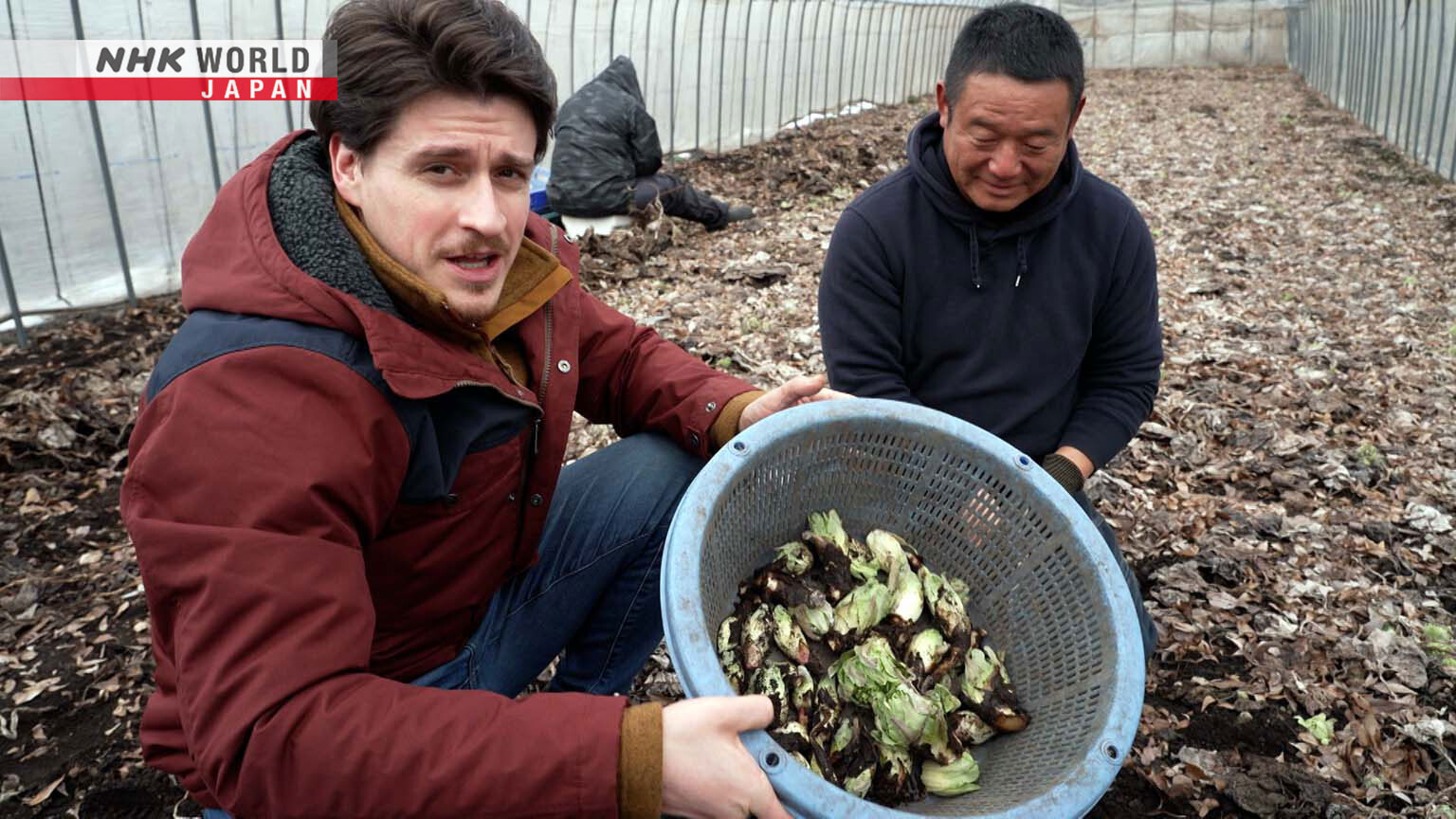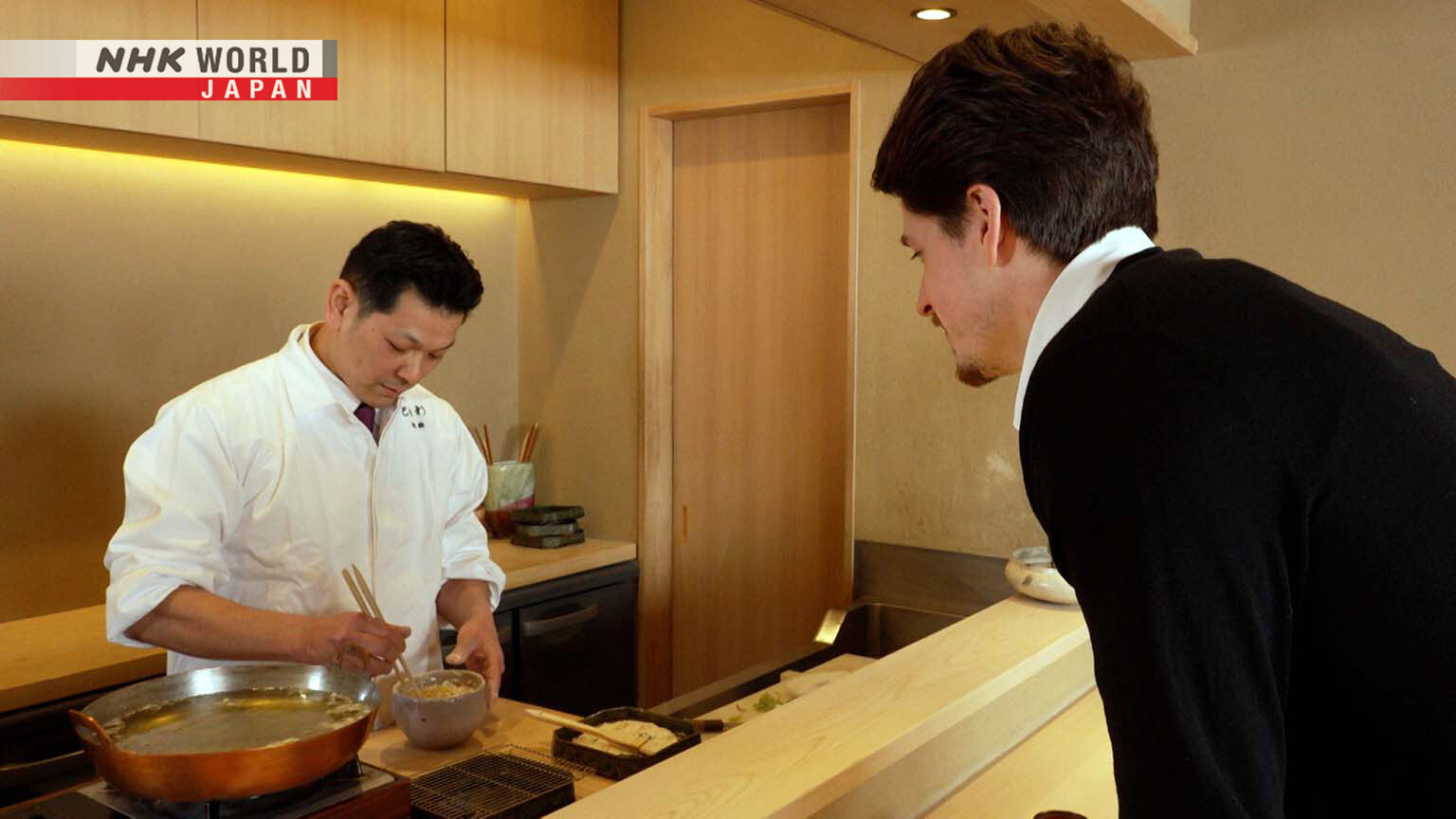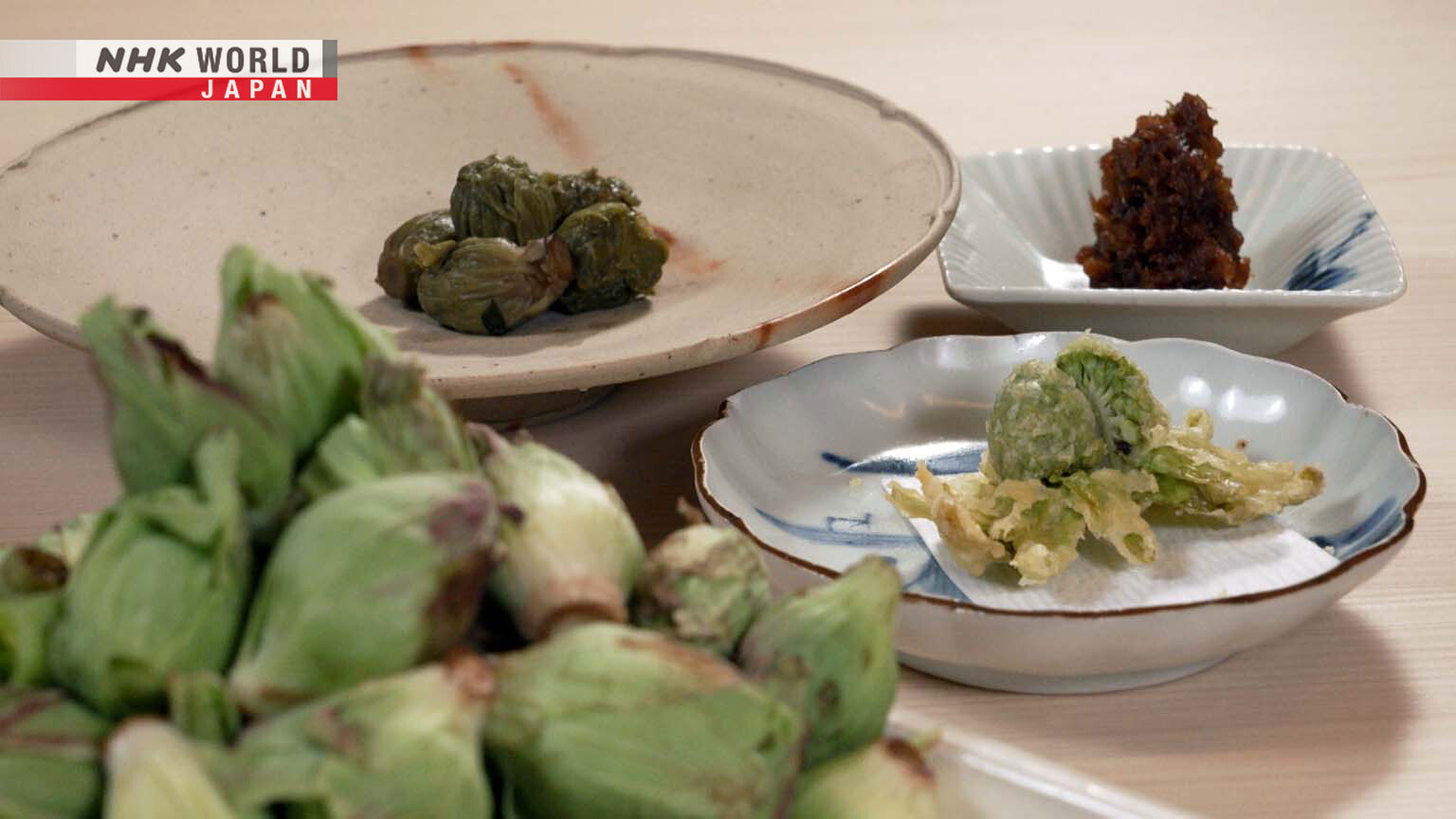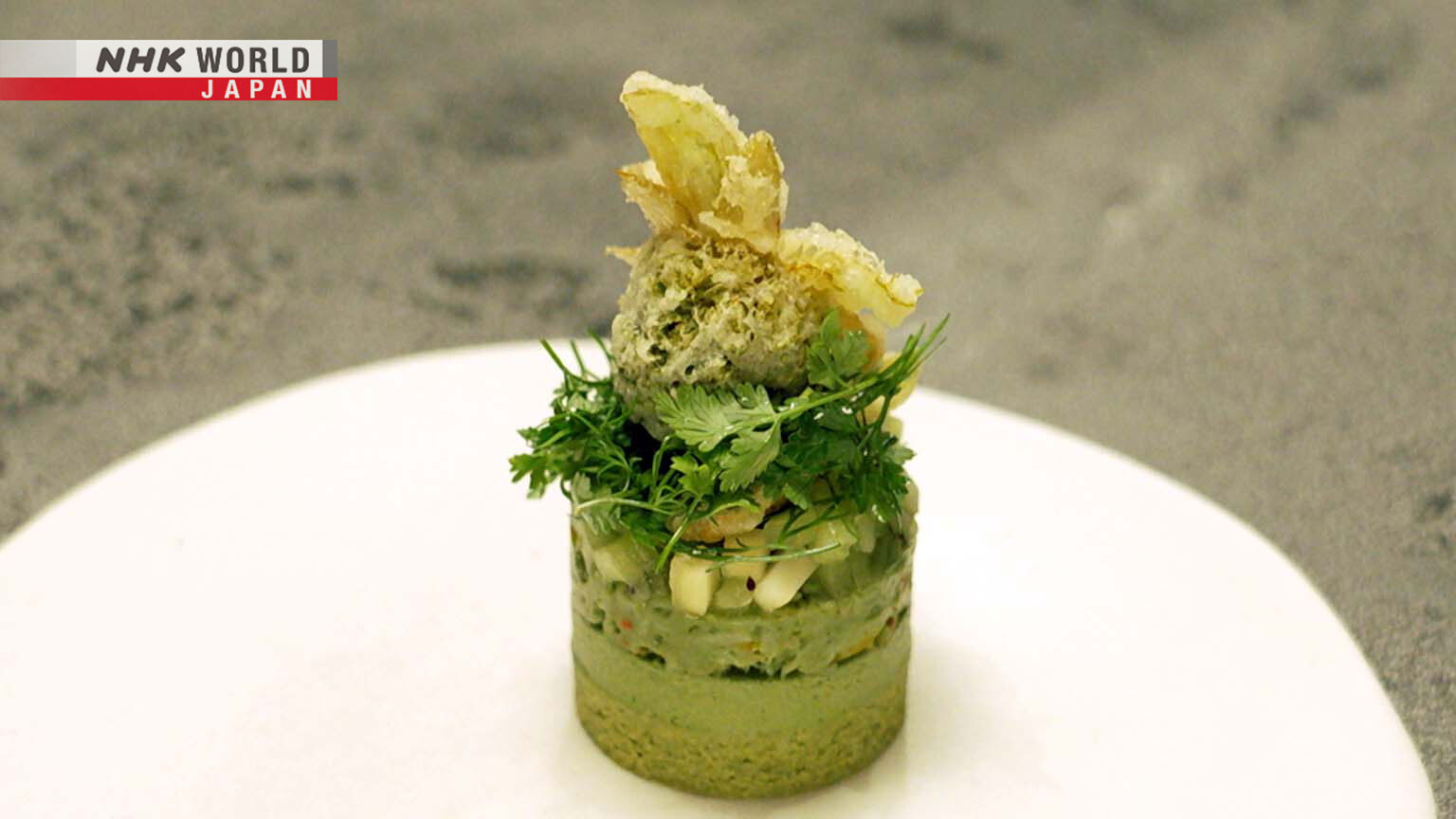FUKINOTO
Fukinoto signals the coming of spring. Shaped like a lovely bouquet, the mountain veggie offers a stimulating bitterness that people wait all year to enjoy. (Reporter: Kyle Card)




Transcript
Tokyo: this world-class metropolis is a veritable gourmet wonderland.
Discover the stories behind the ingredients that make this city so delicious - so "oishii."
Japan's natural landscape offers a variety of "sansai," or mountain vegetables, that have fed bellies for generations.
In most cases, it's the newly-sprouted buds that are eaten.
In the past, they were a key source of nutrition in early spring, when food was scarce.
People would venture deep into the mountains and valleys to harvest what they could find.
This time, we will focus on a well-known "sansai" veggie called "fukinoto," or butterbur sprouts.
They resemble lovely bouquets when sprouted.
Crispy!
And bitter!
They may look cute, but they're quite bitter compared to most other mountain vegetables.
But that's exactly why people like them!
Let's dig in to the charming world of a beloved Japanese veggie, "fukinoto."
Trails to Oishii Tokyo
Hello, everyone.
My name is Kyle Card and I come from Canada.
And today's theme is "fukinoto."
Now, I can't say I know much about this vegetable at all.
I've never encountered it back home, and I can't say I've personally encountered it here in Japan either.
So today is going to be a journey of discovery.
So let's go discover "fukinoto" together.
Kyle, an actor from Canada, will lead the way.
He's at Toyosu Market, Tokyo's major food market.
The produce section offers seasonal fruits and vegetables from across the country.
Whoa. What are these veggies?
I've never seen any of these before.
Kyle found "sansai" - mountain vegetables!
"Sansai" begin showing up at markets in late February when temperatures begin to rise.
For chefs, they're choice ingredients that symbolize the start of spring.
What's this called? "Yuki-urui?"
This one's curly.
This fern called "kogomi" is best eaten just after sprouting, when the leaves are curled.
This is "taranome," the sprouts of a Japanese angelica tree.
"Sansai" come in many varieties, from bud to leaf stalk.
Excuse me.
Where is "fukinoto?"
- Right here.
- Oh, these?
- What is it exactly?
- The flower buds of a vegetable plant called "fuki."
I see!
They look like Brussels sprouts, tiny cabbages.
Yeah, like baby cabbages.
But these are flower buds.
Yes, a common spring mountain vegetable.
- So it's a kind of "sansai?"
- Exactly.
"Fukinoto" and "taranome" are the two most popular sansai this time of year.
- Only this season?
- Around February to March.
I came at the right time.
- May I see one?
- Sure.
Oh, those too?
I need a better view.
- Here they are, the flower buds.
- I see.
It's quite beautiful.
One "fukinoto" sprout contains several clusters of flower buds.
Each bud produces thin white flowers.
They almost look like threads or LED lights.
It doesn't look like food, but we can eat it, right?
Absolutely, you can.
- It's usually eaten whole.
- In one bite?
We use it to make tempura.
So, it's not eaten raw?
- No, it's too bitter.
- Really?
- Extremely, numbingly bitter.
- That much?
Yes.
It would numb your mouth? Then why eat them?
It's a long-standing tradition.
The bitter flavor signals the arrival of spring.
With bitterness comes spring...
Interesting.
Ready to try some "fukinoto," Kyle visits Nishi-Azabu, a famous gourmet district of Tokyo.
Japanese cuisine specialist Matsumoto Kazuki will prepare some today.
These were delivered today. Fresh "fukinoto" harvested in Yamagata yesterday.
Natural?
- Freshly picked?
- That's right.
I made a "fukinoto" flower arrangement for you.
What?
Instead of standard flowers.
How cool!
A growing "fukinoto" stands proudly in a pot, welcoming Kyle.
I'll begin with "fukinoto" tempura.
Sounds good.
He makes a crisscross incision at the root so they cook evenly and quickly.
I spread them open first.
Open them, then fry them?
Yes. That helps them cook through better.
They're coated in a large amount of thick batter so nothing comes off when fried.
The leaves open like flowers once it goes inside the oil.
Putting it in upside down spreads it out nicely.
I see that. Lovely.
Tempura is a classic way to eat "fukinoto."
So crispy.
It's bitter, too!
But it has a nice, fresh flavor.
Crispy outside, juicy inside. It's not a bad bitterness.
- The oil keeps it mild.
- Exactly.
It's just right.
It's wonderful!
I'll make simmered "fukinoto" next.
They have to be boiled to remove lye.
- That's necessary?
- It is.
"Fukinoto"'s scum releases a lingering bitterness when dissolved in water.
This evaporates when "fukinoto" are fried in oil, which suppresses bitterness.
Therefore, no bitterness-removing preparation is needed for tempura.
Now I know why "fukinoto" tempura is so popular.
Faster to make.
When cooking without oil, bitterness is removed by fully boiling the "fukinoto," then soaking them in more water.
Matsumoto usually soaks his for three days.
He then squeezes the water out, and adds the "fukinoto" to a mixture of dashi broth,
sake, and soy sauce in which they'll simmer for two days.
After five days including prep time, the simmered "fukinoto" is ready to eat.
Here we go.
It's well seasoned.
It's more bitter than tempura.
Quite bitter, actually.
A bitter flavor is the main point of "fukinoto." It's the king of bitterness among "sansai."
It was too bitter for me as a kid.
I thought I'd never eat it again, but I grew to like it as an adult.
The bitterness is still lingering.
- Yeah, kids hate that.
- It's relentless.
Adults can handle it better.
- We actually enjoy bitter flavors.
- That's right.
Like beer, coffee, wine...
Why do you take the time to make this?
It's very seasonal, only available between February and April.
That makes it worth our time.
Simmered "fukinoto" can be kept for over a month, which allowed people to enjoy it for a longer period of time.
- That means people really like it.
- Very much so.
Another way to preserve "fukinoto" is by making miso.
You can chop it up?
"Fukinoto" is chopped and stir-fried with dashi broth, sugar, and miso.
In Japan, the miso goes great with a warm bowl of white rice.
"Itadakimasu."
"Oishii." "Fukinoto" and miso pair so well.
They really do.
Sweet, bitter, with good umami.
It clings to the rice nicely.
The "fukinoto" flavor comes through a bit.
Nice aroma.
The rice steam carries the aroma.
Matsumoto also makes desserts using bitter "fukinoto!"
He adds chopped "fukinoto" to mashed yams.
The mixture is pressed through a strainer to make small cylinders.
These are used to cover a ball of sweet "azuki" bean paste.
The result is "fukinoto kinton," a signature dessert.
Cut it down the middle.
There we go.
Nice eating etiquette.
Far off...
the "fukinoto" aroma and bitterness rolls in.
It's said that animals eat mountain veggies as soon as they wake up from hibernation.
They eat bitter foods in spring to detox.
So, I recommend eating bitter foods.
Have the Japanese always considered bitter foods to be good for detox?
- Yes, purification.
- Interesting.
Bitter compounds in "fukinoto" contain many polyphenols, which are said to boost immunity.
"Fukinoto" improve metabolism, helping to release toxins that build up in the body during winter.
Native to Japan, "fukinoto" grow all throughout the country.
They're one of the most common wild vegetables, growing deep in the mountains, on roadsides, and even in private gardens.
10th century writings state that "fukinoto" were presented to the Imperial court as medicinal herbs.
A two-hour drive from Tokyo, Showa is a village in Gunma known as a leading "fukinoto" production area.
In winter, the mountainous region drops to negative temperatures.
- Good morning.
- Good morning.
- Thanks for having me.
- Welcome!
Farmer Kaneko Yoichi works on a 50-year-old farm started by his father.
Where do you grow? Over there?
As you can see, it's quite snowy, so they're in greenhouses now.
They won't grow left out in the cold, so they're covered to warm them up.
- They don't come up when it's cold?
- No.
Therefore, in February, just before harvest, they build greenhouses over them.
Here.
I see.
Popping up here and there.
- So this is "fukinoto." Lovely.
- Yes.
They look cute sticking out like that.
- A sign that spring is coming.
- Right.
We'll harvest this now.
They grow close together.
Dig around the root first.
Then you can pull it up.
Nice sound.
It's attached firmly to the stem.
- Looks nice.
- May I take a look?
Nice.
- Is this a good one?
- Yes.
How can you tell the difference?
If it's blooming like this, it's too late.
Tasty ones are picked just before that, closed like this one.
"Fukinoto" begin to lose texture once they bloom.
So they pick the ones that are still closed.
On Kaneko's farm, harvest lasts for about two weeks.
It's all done by hand, to ensure they carefully attend to all 16 greenhouses without missing anything.
Kyle gives it a try.
Thanks, coach!
Look at that, it's a beaut.
Like one, two, three, four of them, five! Five, five on one shot.
Amazing.
Going well so far.
They find more as they keep digging.
So many!
All in one spot.
The power of "fukinoto."
Kyle gets over 30 "fukinoto" from one node.
Put the soil back.
- More will come?
- Yes.
Can you pick from the same spot next year?
Yes, but they might pop up in slightly different places.
"Fukinoto" grow on a stem underground.
The stems continue growing after harvest until they've spread through the entire field.
New nodes will form on them, which will produce more "fukinoto" by next year.
The stems produce fewer plants after about four years.
Farmers will then take younger, stronger sections of the stems and transport them to a new field.
There, the stems will spread out again, and produce more "fukinoto."
The method is called plant division, whereby "fukinoto" crops are multiplied through cloning.
- If I plant this at home, will I get "fukinoto?"
- You will.
- Powerful!
My father started growing the "fukinoto." Their condition is the same after 50 years.
From the same stem?
The same genes have been passed on for 50 years.
After harvest, something is seen sticking out of the soil.
It will continue to grow taller and taller.
Then, it'll be ready to be shipped as "fuki," a popular spring vegetable.
They grow straight up.
They'll be big after one month.
That's fast.
Again, powerful!
After the "fukinoto" harvest, the "fuki" grow, and you harvest those too?
Exactly.
Fantastic.
The blessing of spring.
"Fuki" is also a spring ingredient.
It's eaten boiled or simmered in sauces.
If you wash or scrub "fukinoto," it'll turn brown and be unsellable.
Instead, the dirty leaves are taken off by hand before the buds are shipped.
Beautiful buds that signal the coming of spring are sent across the country to eager fans.
Kyle will learn to make a simple "fukinoto" dish at Kaneko's home.
What are we making?
My favorite way to enjoy the aroma and flavor of "fukinoto:" ajillo.
Ajillo?
- Let's begin.
- With "fukinoto?"
- Yes.
- Hard to imagine.
It's simple and delicious.
You'll fall in love with "fukinoto."
I see.
Put a generous amount of olive oil into a pan, and fry up some anchovy paste.
Aromatic garlic cloves.
A dash of salt and pepper.
A big batch of "fukinoto" goes in next.
Just like with tempura, the oil takes away bitterness, which makes it easier to eat.
The final touch is bacon and camembert cheese.
"Fukinoto" ajillo, ready to eat.
Excellent! Wow.
Slight bitterness, with umami.
Nice and thick. Perfect level of bitterness.
You can't get this ajillo anywhere else, only in Japan!
I hope people will visit Japan just to eat "fukinoto" dishes.
So good!
Back in Tokyo...
Kyle's "fukinoto" journey ends in Shoto, an upscale residential area near Shibuya.
He'll visit a restaurant that's a bit of a hidden gem.
Matsumoto Yuki honed his skills at a starred restaurant in France.
After returning home, he wanted to make French cuisine with ingredients unique to Japan.
Wow.
Is this cake?
It's a "fukinoto" appetizer. It looks like cake, but it's not sweet.
It's a savory dish.
Beautiful.
"Fukinoto" is on top?
It's all "fukinoto," actually.
Everything?
The base is steamed bread kneaded with "fukinoto" paste.
Over that is a creamy flan.
On top of that is snow crab dressed with "fukinoto" paste.
Then, a mix of firm, tart kiwis and herbs.
"Fukinoto" is fried in a yeast-infused batter for extra crunchiness, and placed at the very top.
Oh, just the perfect balance of so many flavors.
It's not completely, like, blunting out the bitterness, but it's just keeping just enough, and just bringing all these different accents of,
like, sweetness and sour and savory and, like, a creaminess.
It just creates this wonderful interplay of flavors and textures as well.
Bitterness is key. But "fukinoto" is too bitter as-is.
I didn't taste any harsh flavor.
That's thanks to the fat content. Fats make it much milder.
Fats and dairy work together to bring out the best in "fukinoto."
A balancing act between bitter and savory.
Fried "fukinoto."
Steamed bread and flan containing milk and butter.
And an herb salad with an aromatic "yuzu" dressing.
Combining various oils and fats makes "fukinoto" less bitter and more aromatic.
Now for the main dish of the day.
What's this?
It looks like modern art!
This is quail meat wrapped in a "fuki" leaf.
Between the meat and leaf is "fukinoto" miso.
A French dish inspired by traditional Japanese cuisine.
Looks great.
Lovely pink color there.
Juicy.
It's like wonderfully juicy.
And get these, like, lovely bitter tones from the "fukinoto" miso.
Brings out the bitterness a little bit more.
But again, not too much bitterness.
Just enough bitterness.
It just really complements the juiciness and the umami of the flesh here.
Quail meat has a uniquely light and gentle flavor.
To enhance that flavor, Matsumoto adds bitterness by incorporating "fukinoto" miso and charcoal-grilled "fuki" leaves.
The bitterness and leaf fibers make you chew more.
Chewing brings out more flavors.
This works in combination with the quail flavors to create an exciting experience.
For this, I mixed "fukinoto" with miso and used "fuki" leaves.
The sauce is made from "fuki" stems.
Several "fuki" parts went into one dish. That makes it luxurious in my opinion.
Few ingredients can be used this way.
When spring comes, the bitterness of "fukinoto" will surely invigorate you.
Enjoy a flavor experience that, for now, can only be had right here in Japan.
In Tokyo, every ingredient has its own story.